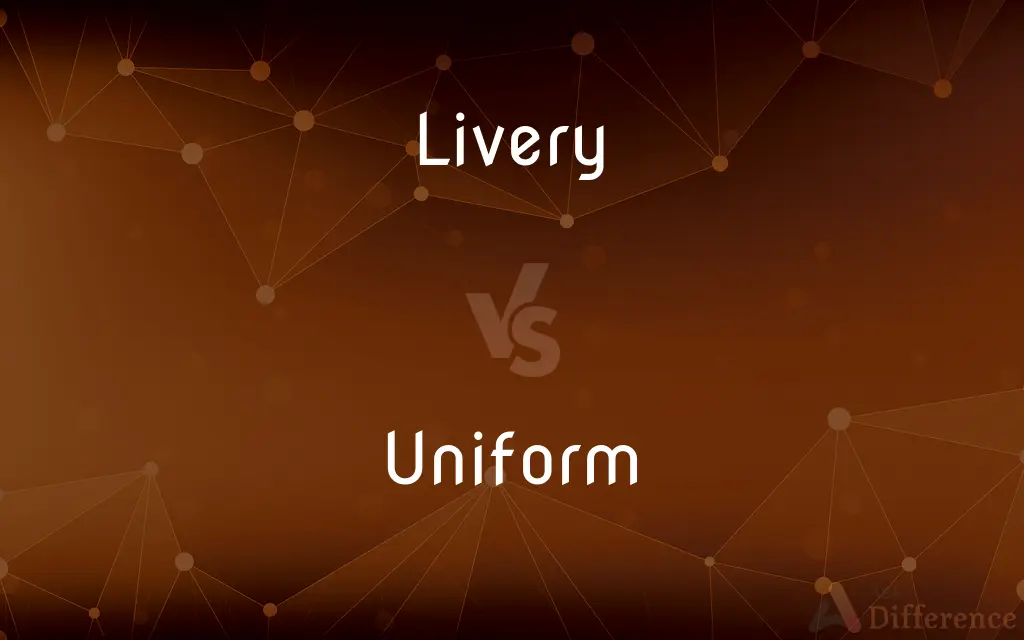Livery vs. Uniform — What's the Difference?
Edited by Tayyaba Rehman — By Fiza Rafique — Updated on March 31, 2024
Livery is specific attire for servants or employees, signifying allegiance, while a uniform is standard clothing for members of an organization, emphasizing identity and unity.

Difference Between Livery and Uniform
Table of Contents
ADVERTISEMENT
Key Differences
Livery originally referred to special clothing given to servants or household members, historically denoting their service to a particular lord or lady, often richly adorned to reflect the status of the employer. In contrast, a uniform is a standardized set of clothing worn by members of an organization, such as military personnel, school students, or corporate employees, to denote membership, role, and often rank within the organization.
While livery emphasizes the relationship and allegiance between a servant or employee and their employer, highlighting status and belonging to a specific household or entity, uniforms focus on creating a sense of unity, equality, and collective identity among all members of an organization. Uniforms are designed to eliminate personal distinctions of wealth or status, promoting a cohesive appearance.
In modern contexts, the term "livery" has evolved to include branded clothing in certain service industries, such as airlines or hospitality, where employees wear attire that matches the company’s colors or logos. This modern usage blurs the lines somewhat with uniforms but retains the element of denoting service to a particular entity.
Uniforms are widely used across various sectors, including the military, emergency services, schools, and corporate sectors, each with its specific design to serve practical purposes, such as camouflage for military uniforms, or to foster team spirit and discipline, as in school uniforms.
The choice between livery and uniform often depends on the context and the desired emphasis on either service and allegiance (livery) or unity and identity (uniform). Despite their differences, both play significant roles in denoting association with and representation of a particular group or entity.
ADVERTISEMENT
Comparison Chart
Origin
Historically given to servants to signify service and allegiance.
Worn by members of an organization to denote membership and unity.
Purpose
To show affiliation with a specific employer or household.
To create a cohesive, unified appearance among members.
Emphasis
Allegiance and service to an employer.
Unity, identity, and sometimes rank within an organization.
Modern Usage
Evolved to branded attire in service industries.
Standardized across various sectors for identity and practicality.
Examples
Historical household servants, airline uniforms.
Military, emergency services, school, and corporate uniforms.
Compare with Definitions
Livery
Special attire for identifying servants or employees with their employers.
The hotel staff wore a distinctive livery matching the hotel’s branding.
Uniform
Often includes insignia indicating rank or role.
Military uniforms display rank through stripes or badges.
Livery
Can be ornate and specific to rank within service.
The head butler's livery was more elaborate than that of the junior staff.
Uniform
Designed for practicality in various professions.
Firefighter uniforms are made from fire-resistant materials.
Livery
Historically denoted allegiance to a noble house.
Medieval servants wore livery in their lord's colors.
Uniform
Standardized attire worn by members of an organization.
Police officers wear a uniform that denotes their authority and role.
Livery
In modern times, often branded clothing in service industries.
Airline attendants’ livery includes a logo scarf or tie.
Uniform
Enhances corporate identity and team spirit.
Corporate uniforms at conventions make employees easily identifiable.
Livery
Reflects the employer's status and branding.
Luxury hotels design their livery to reflect the establishment's prestige.
Uniform
Aims to promote unity and equality among wearers.
School uniforms help minimize social distinctions among students.
Livery
A livery is a uniform, insignia or symbol adorning, in a non-military context, a person, an object or a vehicle that denotes a relationship between the wearer of the livery and an individual or corporate body. Often, elements of the heraldry relating to the individual or corporate body feature in the livery.
Uniform
A uniform is a type of clothing worn by members of an organization while participating in that organization's activity. Modern uniforms are most often worn by armed forces and paramilitary organizations such as police, emergency services, security guards, in some workplaces and schools and by inmates in prisons.
Livery
A distinctive uniform worn by the male servants of a household.
Uniform
Always the same, as in character or degree; unvarying
Planks of uniform length.
Livery
The distinctive dress worn by the members of a particular group; uniform
Ushers in livery.
Uniform
Being the same as or consonant with another or others
Rows of uniform brick houses.
Livery
The costume or insignia worn by the retainers of a feudal lord.
Uniform
A distinctive set of clothing intended to identify the members of a specific group
A police uniform.
Livery
The boarding and care of horses for a fee.
Uniform
To make (something) uniform.
Livery
The hiring out of horses and carriages.
Uniform
To provide or dress with a uniform.
Livery
A livery stable.
Uniform
Unvarying; all the same.
Livery
A business that offers vehicles, such as automobiles or boats, for hire.
Uniform
Consistent; conforming to one standard.
Livery
(Law) Official delivery of property, especially land, to a new owner.
Uniform
(mathematics) with speed of convergence not depending on choice of function argument; as in uniform continuity, uniform convergence
Livery
Any distinctive identifying uniform worn by a group, such as the uniform worn by chauffeurs and male servants.
Uniform
Composed of a single macromolecular species.
Livery
The whole body of liverymen, members of livery companies.
Uniform
(geometry) (of a polyhedron) That is isogonal and whose faces are regular polygons; (of an n-dimensional (n>3) polytope) that is isogonal and whose bounding (n-1)-dimensional facets are uniform polytopes.
Livery
The paint scheme of a vehicle or fleet of vehicles.
The airline's new livery received a mixed reaction from the press.
Uniform
A distinctive outfit that serves to identify members of a group.
Livery
(US) A taxicab or limousine.
Uniform
(international standards) nodot=1 NATO/ICAO Phonetic Alphabet.}}
Livery
(legal) The delivery of property from one owner to the next.
Uniform
(police) A uniformed police officer (as opposed to a detective).
Livery
(legal) The writ by which property is obtained.
Uniform
(transitive) To clothe in a uniform.
Livery
(historical) The rental of horses or carriages; the rental of canoes; the care and/or boarding of horses for money.
Uniform
Having always the same form, manner, or degree; not varying or variable; unchanging; consistent; equable; homogenous; as, the dress of the Asiatics has been uniform from early ages; the temperature is uniform; a stratum of uniform clay.
Livery
(historical) A stable that keeps horses or carriages for rental.
Uniform
Of the same form with others; agreeing with each other; conforming to one rule or mode; consonant.
The only doubt is . . . how far churches are bound to be uniform in their ceremonies.
Livery
An allowance of food; a ration, as given out to a family, to servants, to horses, etc.
Uniform
A dress of a particular style or fashion worn by persons in the same service or order by means of which they have a distinctive appearance; as, the uniform of the artillery, of the police, of the Freemasons, etc.
There are many things which, a soldier will do in his plain clothes which he scorns to do in his uniform.
Livery
Release from wardship; deliverance.
Uniform
To clothe with a uniform; as, to uniform a company of soldiers.
Livery
A low grade of wool.
Uniform
To make conformable.
Livery
Outward markings, fittings or appearance
Uniform
Clothing of distinctive design worn by members of a particular group as a means of identification
Livery
(archaic) To clothe.
He liveried his servants in the most modest of clothing.
Uniform
Provide with uniforms;
The guards were uniformed
Livery
Like liver.
Uniform
Always the same; showing a single form or character in all occurrences;
A street of uniform tall white buildings
Livery
Queasy, liverish.
Uniform
The same throughout in structure or composition;
Bituminous coal is often treated as a consistent and homogeneous product
Livery
The act of delivering possession of lands or tenements.
Uniform
Not differentiated
Livery
Release from wardship; deliverance.
It concerned them first to sue out their livery from the unjust wardship of his encroaching prerogative.
Uniform
Evenly spaced;
At regular (or uniform) intervals
Livery
That which is delivered out statedly or formally, as clothing, food, etc.
A Haberdasher and a Carpenter,A Webbe, a Dyer, and a Tapicer,And they were clothed all in one liveryOf a solempne and a gret fraternite.
From the periodical deliveries of these characteristic articles of servile costume (blue coats) came our word livery.
Livery
Hence, any characteristic dress or outward appearance.
Now came still evening on, and twilight grayHad in her sober livery all things clad.
Livery
A low grade of wool.
Livery
An allowance of food statedly given out; a ration, as to a family, to servants, to horses, etc.
The emperor's officers every night went through the town from house to house whereat any English gentleman did repast or lodge, and served their liveries for all night: first, the officers brought into the house a cast of fine manchet [white bread], and of silver two great pots, and white wine, and sugar.
Livery
The feeding, stabling, and care of horses for compensation; boarding; as, to keep one's horses at livery.
What livery is, we by common use in England know well enough, namely, that is, allowance of horse meat, as to keep horses at livery, the which word, I guess, is derived of livering or delivering forth their nightly food.
It need hardly be observed that the explanation of livery which Spenser offers is perfectly correct, but . . . it is no longer applied to the ration or stated portion of food delivered at stated periods.
Livery
The keeping of horses in readiness to be hired temporarily for riding or driving; the state of being so kept; also, the place where horses are so kept, also called a livery stable.
Pegasus does not stand at livery even at the largest establishment in Moorfields.
Livery
To clothe in, or as in, livery.
Livery
Uniform worn by some menservants and chauffeurs
Livery
The voluntary transfer of something (title or possession) from one party to another
Livery
The care (feeding and stabling) of horses for pay
Livery
Suffering from or suggesting a liver disorder or gastric distress
Common Curiosities
Can livery be considered a type of uniform?
In a broad sense, yes, as both denote association with a specific entity, but livery has a more specific connotation of service and allegiance.
What role do uniforms play in the military?
In the military, uniforms denote membership, rank, and role, and are designed for practicality and camouflage, enhancing unity and discipline.
Why do schools use uniforms?
Schools use uniforms to foster a sense of equality, discipline, and collective identity among students, reducing social distinctions.
How do companies decide between livery and uniform for employees?
The decision often depends on the industry, the company’s branding strategy, and the desired emphasis on either service (livery) or collective identity (uniform).
What is the primary difference between livery and uniform?
Livery emphasizes service and allegiance to an employer, while uniforms focus on unity and collective identity within an organization.
How do cultural differences influence the design of livery and uniforms?
Cultural differences can significantly influence the design, incorporating traditional colors, patterns, or styles to reflect the organization's heritage or the local culture.
Is the use of livery or uniform more effective in promoting brand identity?
Both can be effective in different contexts: livery in emphasizing service and brand experience, and uniforms in promoting team unity and brand consistency.
How has the concept of livery evolved over time?
Livery has evolved from signifying service to nobility to now representing branding and service in modern industries, like airlines and hospitality.
Can livery include accessories or only clothing?
Livery can include accessories, such as badges, hats, or scarves, that complement the clothing and enhance the branding or allegiance.
What impact does wearing a uniform have on individuals in an organization?
Wearing a uniform can enhance a sense of belonging, minimize personal distinctions, and promote a professional, unified image.
Share Your Discovery

Previous Comparison
Holiday vs. Leave
Next Comparison
Gullet vs. OesophagusAuthor Spotlight
Written by
Fiza RafiqueFiza Rafique is a skilled content writer at AskDifference.com, where she meticulously refines and enhances written pieces. Drawing from her vast editorial expertise, Fiza ensures clarity, accuracy, and precision in every article. Passionate about language, she continually seeks to elevate the quality of content for readers worldwide.
Edited by
Tayyaba RehmanTayyaba Rehman is a distinguished writer, currently serving as a primary contributor to askdifference.com. As a researcher in semantics and etymology, Tayyaba's passion for the complexity of languages and their distinctions has found a perfect home on the platform. Tayyaba delves into the intricacies of language, distinguishing between commonly confused words and phrases, thereby providing clarity for readers worldwide.














































